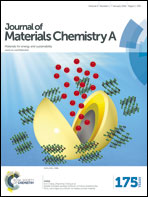Enhancing the crystallization and optimizing the orientation of perovskite films via controlling nucleation dynamics†
Abstract
The morphology of the active layer is at the heart of perovskite solar cells. It is deeply related to charge transport and extraction, which depend on coverage ratio, crystallinity, crystal size and perhaps crystal orientation. However, the crystallization process in a solution-processed perovskite film is ungovernable and there is no clear guideline for how to improve the film morphology. Here, we employed the selective solvent annealing (SSA) method to control crystallization kinetics, producing a flat CH3NH3PbIxCl3−x film with almost full coverage, micron scale grain size, enhanced crystallinity and optimized crystal orientation. The improved morphology is attributed to the formation of a uniformly distributed nucleus of perovskite before thermal annealing, resulting from the selective solubility of selective solvents, which accelerates the crystallization of lead iodide (PbI2) and the intercalation of methylammonium iodide (MAI) into the PbI2 crystal lattice. Furthermore, driven by thermodynamics, the nucleus tends to rearrange during the thermal annealing process, and thus the crystal orientation turns from (h k 0) (h = k) to (h 0 0) orientation, which enables the corner of the inorganic framework to come into contact with the substrate. The enhanced crystallinity, enlarged crystal size and optimized crystal orientation are beneficial for the carrier collection due to the prolonged carrier life time and reduced carrier recombination, which resulted in the highest power conversion efficiency (PCE) of 12.38%, about 37% increase compared with the reference device.


 Please wait while we load your content...
Please wait while we load your content...